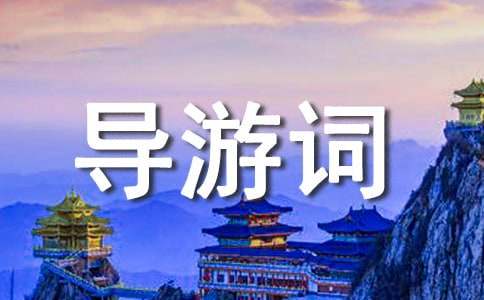- 相关推荐
广州景点导游词
作为一名乐于为游客排忧解难的导游,就难以避免地要准备导游词,导游词是导游员同游客交流思想,向游客传播文化知识的讲解词。那么问题来了,导游词应该怎么写?以下是小编整理的广州景点导游词,仅供参考,大家一起来看看吧。

广州景点导游词1
Another tourist attraction in Kaiping City is the Li Garden. It was a private residential garden built in 1926 – 1936 by an American Chinese, Xie Wei Li by name. The garden’s name “Li” was derived from the name of its owner and it gives expression to the meaning of a Chinese idiom Xiu Shen Li Ben, which is written on an archway in the garden, meaning that cultivating one’s moral and character is the key to success in one’s life and work. This idea of the owner’s is also embodied in many other inscriptions and couplets written in the garden.
The Li Garden is laid out in the way of traditional Chinese gardening but many of its structures are built in Western styles, such as the two Roman-styled structures popularly known as the Bird’s Nest and the Flower & Rattan Pavilion. The garden covers an area of 19, 600 square meters, with a man-made stream running through and cutting it into two parts, which are connected by arch-bridges. Along the stream are pavilions, a hundred-meter-long corridor, archways, residential houses and other structures.
The residential buildings in the villa area are also combinations of Chinese and Western architectural elements. While their main structures are foreign-styled, some are roofed like a Chinese palace, and inside they are decorated and furnished with both Chinese and foreign artifacts: Western fireplace and pendent lamps, Italian ceramic tiles, Chinese wooden furniture, wall paintings depicting Chinese folk stories, Chinese gilded wood-carvings etc.
The Li Garden is indeed a paragon of harmonious combination of the Chinese and foreign cultures.as a watchtower for it was located in an open land and was provided with electric generator,searchlights and guns.
广州景点导游词2
The Six Banyan Pagoda was built for keeping Buddhist relics. According to the records, some holy ashes from Buddha’s teeth, a sword, a bronze tripod and some other Buddhist treasures are buried under the foundation of the pagoda. This octagonal magnificent pagoda, with its blue glazed tiles, vermilion beams, painted walls and red pillars all in good match, looks like a flowery column and so it is often referred to as the “Flowery Pagod”a.
The highlight of the visit to the temple is to climb the pagoda. This 57-meter-high pagoda looks to have only 9 stories on the outside but actually has 17 stories inside. On each of the 9 external floors, there are many entrances leading to its interior but only one is accessible to the staircase.
So, if you lose your way, you just turn around the circle and you will find your way up or down! On the top floor, there is a huge bronze column with 1023 Buddha figurines in relief. Cast in 1358, this bronze column, together with its attachments, weighs over 5 tons
广州景点导游词3
各位游客欢迎来到广州光孝寺,我是你们的导游xx。
光孝寺是广州众多古迹中历史最长、文物最多的一处景点。光孝寺与潮州开元寺、韶关南华寺、肇庆鼎湖庆云寺并称广东四大名寺,距今已有1500多年的历史。所以广州人常说“未有羊城,现有光孝”,可见其历史之悠久。光孝寺位于广州光孝路,以历史悠久,规模宏伟为岭南佛教丛林之冠。光孝寺的寺址初为南越王赵佗的玄孙,五代南越王赵建德的王府。在三国时代,东吴的骑都尉虞翻被贬到广州,他不甘寂寞,在此开辟苑圃、讲学授徒,并种下了许多的柯子树,所以当时的人们都称这里为“柯林”。
虞翻死后,他的家人将苑圃捐为寺庙,取名“制止寺”。后来又多次改名,直到南宋1151年,才正式定名为报恩光孝禅寺,简称光孝寺。不少南亚、印度高僧曾来寺院传教译经,对中外文化交流有很大的影响。清代以来,寺院逐渐缩小,但迄今为止,面积仍达到3.1万多平方米。光孝寺中轴线起由南往北的建筑计有山门、天王殿、瘗发塔;西面有大悲幢、西铁塔、墨廊;东面有六祖殿、迦蓝殿、洗钵泉、碑廊;再往东有睡佛阁、洗砚和东铁塔等。
光孝寺不但历史长、文物多,而且不少文化名人和佛教高僧都曾在此停驻过,使光孝寺成为岭南文化与中原文化交流以及岭南佛教的传播地。这些人物,除了我刚才提到过的虞翻外,早在东晋时期,就有西域的名僧昙摩耶舍来到广州传教,并在这里建了大雄宝殿。梁朝时,印度僧人智药禅师也来到这里,还带来了一株菩提树苗种在了寺庙
’从此菩提树就在中国扎下了根。据说,全国的菩提树都是从光孝寺里引种出去的,当时,大名鼎鼎的菩提达摩也带着释迦佛的衣钵来到光孝寺传播佛教。在众多的名人中,最为著名的就是佛教禅宗南派创始人六祖慧能大师了。一提起他,大家都可能想起他那著名的偈语“菩提本无树,明镜亦非台,本来无一物,何处惹尘埃”。但又有哪位游客知道慧能是在哪里削发剃度的呢?就是在光孝寺的菩提树下。
【光孝寺门前】
游客们有没有看到光孝寺门前的这副对联“五羊论古树,初地访柯林”,其实讲的就是光孝寺的沿革。这“古树”指的就是当年智药禅师种下的菩提树;“初地”就是指达摩东渡到了广州登岸的地方,被称为“西来初地”,当年虞翻在此种下的柯子树,所以光孝寺又叫做“柯林”。
【天王殿】
这里就是天王殿了。中间这位笑呵呵的,就是大家熟悉的弥勒佛了。弥勒佛也叫笑佛、大肚佛,又叫布袋和尚。在弥勒佛的两边,是威风凛凛的四大天王,他们手执法器,各司其职,分别是剑锋、琵琶、雨伞、龙蛇,合起来正好是“风调雨顺”的意思,表达了人们对生活的美好愿望。大雄宝殿里坐在正中间的这一位就是释迦牟尼了。只见他结跏趺坐,左手横放在左脚上,右手举起,曲指作环形,正在向众生说法。侍立在两旁的,是迦叶苦者和阿难苦者。迦叶年长,在左抱拳,阿难年轻,在右合掌。
在释迦牟尼的两边还有两位菩萨,左边的是文殊师利,又叫大智菩萨,右边是普贤,这三尊佛像合起来便称作“华严三圣”。大家看,释迦牟尼像的后面还有一座千手千眼观音像,有哪位游客知道千眼观音的来历呢?据佛经上讲,观音在千光令表如来说法,就立下大誓,要“利益安乐一切众生”。于是身上就长出了千眼;千手表示遍护众生,千眼表示遍观世间,那都是大慈大悲,法力无边的表现。
睡佛殿里的汉白玉佛是缅甸汉白玉雕成,长4米,重6吨多,刻的是释迦牟尼的涅槃像。整座睡佛显得神态安详,体态自然。传说当年释迦牟尼为了传播佛教,几乎走遍了印度半岛,当他来到拘尸那伽时,已是重病缠身,生命垂危了。于是佛就在四株娑树中间枕着手,侧身卧着圆寂了。后来所有的卧佛像都雕成了这样的.姿势。
【大雄宝殿后的瘗(yi)发塔】
瘗发塔共有七层,高7.8米,塔的每层都有8个小佛像。塔的基座是以红砂岩所建。整座塔塔形秀丽,是我省乃至我国都极为少见的唐代佛塔。这座塔和塔右边的那株菩提树见证了我国佛教史上极为重要的一幕。当年六祖慧能大师在湖北黄梅东山寺得到禅宗弘忍法师的衣钵真传后,因为被其他人迫害,逃回岭南。
676年,慧能来到光孝寺来,正好光孝寺的主持印宗法师在此讲经。这时清风徐来,吹动了佛幡,下面的僧人就争论起来,有的说是“风动”,有的说是“幡动”。正在争论不休时,慧能站出来说“不是风动,也不是幡动,而是心动”,众僧人大为佩服。最后在印宗法师的一再追问下,慧能终于道出自己的真实身份。于是印宗法师就在菩提树下为慧能落发受戒,并拜慧能为师,又建造了瘗发塔,将慧能的头发埋在了塔下,从此,慧能成了禅宗南派的领袖,光孝寺因此而扬名海内外。
【菩提树】
这棵枝叶繁茂的大树就是菩提树了,可惜的是,当年智药禅师所种的菩提树已在清嘉庆年间被台风吹折,这棵菩提树是从韶关的南华寺分植过来的,有180多年的树龄了。南华寺的菩提树是当年从光孝寺中移植去的。
【六祖堂】
现在我们来到六祖堂。这是为了纪念六祖惠能而建的。六祖堂建于北宋真中年间,后来又经多次维护。大家请看,这位神态安详,充满智慧的雕像就是慧能了。那么请问,前五祖是谁呢?现在我来告诉大家,他们分别是初祖达摩,二祖慧可,三祖僧璨,四祖道信,五祖弘忍,惠能就是六祖了。说到六祖,我给大家讲一段有趣的故事。这段故事在佛教界非常有名。当年五祖弘忍再湖北黄梅东山寺传法,感到自己年老体衰,想把衣钵,也就是自己的位置传给一位有慧性的徒弟。
为了给大家一个平等的机会,吩咐他们每人做一首诗来显示自己的慧性,感觉自己有能力接受衣钵,就把这首诗写在寺院粉墙上。他的大弟子神秀就写了这样一首诗“身是菩提树,心是明镜台,时时勤拂拭,莫使惹尘埃”。我们知道,佛教讲的是一切皆空,越是能体味“空”的含义,悟性就越高。五祖看了以后说,还可以,但还没有真正悟透。
后来一个小和尚知道这件事也想试一试,但他不识字,就口授一首诗,请人帮他写在墙上。这就是前面提到的“菩提本无树,明镜亦非台,本来无一物,何处惹尘埃”。这首诗比神秀“空”得更彻底了。五祖看到以后,非常赞赏,找到小和尚,在他头上敲了三下就走了。小和尚悟性很高,当晚三更到五祖房里去了,五祖传给他衣钵法器,赐名惠能,成为禅宗六祖,让他连夜往南方去了。后来惠能就在六祖堂前面的菩提树下落发受戒传授禅宗南派。
广州景点导游词4
The entrance hall of the temple is called The Hall of Heavenly Kings and is the shrine for Mile Buddha (Maitreya) and the Heavenly Kings (or the Divas as are called in Buddhist sutra).The statue in the middle, the man with a big belly, is Mile Buddha, who is commonly known as the Laughing Buddha because he is always grinning from ear to ear.
He is the future savior that will deliver all living beings to the Buddhist paradise after Sakyamuni’s Buddhist power is exhausted, and so he is also known as the Future Buddha. The couplet on both sides is a compliment to the Laughing Buddha, meaning literally: “A big belly can hold the world’s troubles that are troubling people. An open mouth is smiling at those who are to be smiled at.”
On either side of the hall we can see two statues. They are the four Heavenly Kings, who are protectors of Buddhist doctrines, with each taking care of one side-the east, west, north and south. It is their joint efforts that ensure harmony, peace and prosperity of the world. The four objects they are holding-a "pipa"(a Chinese pluck instrument),an umbrella, a snake and a sword-combine to mean that Buddha will ensure a favorable weather for the crops so that people may live a happy life.
Statue at the back of the Laughing Buddha is the patron of the temple, Wei Tuo or Veda by name, who is number one among the 32 generals under the four Heavenly Kings.
【广州景点导游词】相关文章:
景点导游词09-24
重庆景点导游词06-26
北京景点导游词06-13
喀纳斯景点的导游词07-20
天津景点导游词10-04
经典的故宫景点导游词09-24
成都景点导游词08-06
西安景点导游词11-11
赵州桥景点导游词11-08
浙江景点导游词10-24